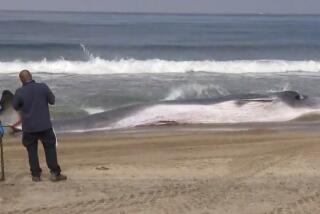Heavyweight Attraction
El Nino might be starving the sea lions and spawning storms, but the California gray whales just keep coming.
The holiday season also kicks off the whale-watching season along the Southern California coastline, and scientists say El Nino hasn’t deterred these huge beauties from their annual trek--so far, anyway.
You can get a glimpse of them almost every day through March as they migrate from Alaska to the warm-water lagoons of Baja California and back.
“It’s one animal that’s not affected,” said Steven Webster, marine science advisor for the Monterey Bay Aquarium.
The warm water of El Nino has driven away the prey of sea lions, such as squid and anchovies. But the California gray whales don’t depend on a hearty food supply during their long voyage. They build up layers of fat, or blubber, in Alaska before they leave.
“They are on a mission to get to the lagoons and drop their calves,” Webster said. They are not hanging around to feed, he said, except maybe for a little snack from the kelp forests if the opportunity arises.
Stormy weather doesn’t faze them much. The harsh storms in 1983 didn’t stop the gray whale from reaching the lagoons, according to Larry Fukuhara, program director of the Cabrillo Marine Aquarium in San Pedro.
“There were plenty of whales there,” he said. “It was a rough ride but they had to get down.”
Area whale-watching cruise operators say they’re spotting the usual number of whales for this time of year. Island Packer Cruises, which operates whale-watching trips out of Ventura and Channel Islands harbors, kicked off the whale season Dec. 26, spotting whales between Anacapa and Santa Cruz islands and at the entrance to the Oxnard harbor.
“The whales are here,” said Island Packer’s Cherryl Connally. The number of sightings usually picks up after New Year’s Day, when passengers might see an average of three or four whales. By mid-January, the average might be six or eight, she said.
In March, when the whales pass by again on the return trip to Alaska, they are usually more frisky, Connally said. “They’re not in such a hurry. They completely breech out of the water.”
It’s not a sure thing that you’ll see any whales on the half-day or all-day cruises that cross the channel separating the coast from the Channel Islands. But the chances are pretty good that you’ll see dolphins.
If you’re squeamish about cruising the seas, you can learn a lot about the gray whales from the shore. Starting Jan. 10, California State Parks offers several free programs from the shore about these amazing creatures. If you bring binoculars, you might glimpse them cruising by.
The gray whales leave Alaska in October and head south to give birth to their babies. They glide along at about 5 mph, covering roughly 115 miles per day, with the pregnant whales leading the migration. After lazing about in the lagoon, the whales and their newborns head back to Alaska, ending the 6,000-mile journey.
From the cruise guides and park rangers, you’ll glean some interesting tidbits about these mammals. You’re likely to hear the story of how the whales’ barely survived the whaling era. Since they became a protected species in the United States, their numbers have grown from a low of about 8,000 during the early 1900s to an estimated 22,000.
They are 15 feet long at birth and grow to about 40 feet at full maturity. They can weigh as much as 40 tons. They can remain submerged for up to 15 minutes.
All that may be impressive, but nothing quite matches the excitement of spotting the familiar spout of mist from along the horizon. Cruise in for a closer look--and if you’re lucky, you might witness the spectacular sight of a whale breeching, heaving most of its massive bulk out of the water and plunging back down with a tremendous splash.
(BEGIN TEXT OF INFOBOX / INFOGRAPHIC)
BE THERE
Several companies offer whale-watching trips or programs, including:
Island Packer Cruises, operating out of Ventura and Channel Islands harbors, offers daily half-day trips at 9:30 a.m. and 1:30 p.m. Boats are 55-75 feet; cost is $22 for adults, $15 for children 12 and under, and $20 for seniors. All-day trips start at $37 for adults. (805) 642-1393.
Cisco Sportfishing, operating whale trips out of Channel Islands Harbor beginning Saturday, offers daily half-day trips at 9 a.m. and 1 p.m. Boat is 65 feet; cost is $21 for adults, $15 for children and seniors. (805) 985-8511.
Whale watching aboard the 88-foot Condor, affiliated with the Santa Barbara Museum of Natural History and operating out of Santa Barbara’s Sea Landing, offers all-day trips, 8 a.m. to 5 p.m. Cost is $65 for adults, $35 for children 12 and younger. In mid-February, the Condor will embark on 2 1/2-hour trips. (805) 882-0088.
California State Parks offers several free one- to two-hour whale programs from the shore. The first is Jan. 10, 12:30 p.m., at Malibu Creek Lagoon, off Pacific Coast Highway in Malibu. Other programs are scheduled for Jan. 16 at 4:30 p.m. and Jan. 18, 2:30 p.m., at Leo Carrillo State Beach, off Pacific Coast Highway at the Ventura County-Los Angeles County line. (310) 457-8142.
More to Read
Sign up for The Wild
We’ll help you find the best places to hike, bike and run, as well as the perfect silent spots for meditation and yoga.
You may occasionally receive promotional content from the Los Angeles Times.






